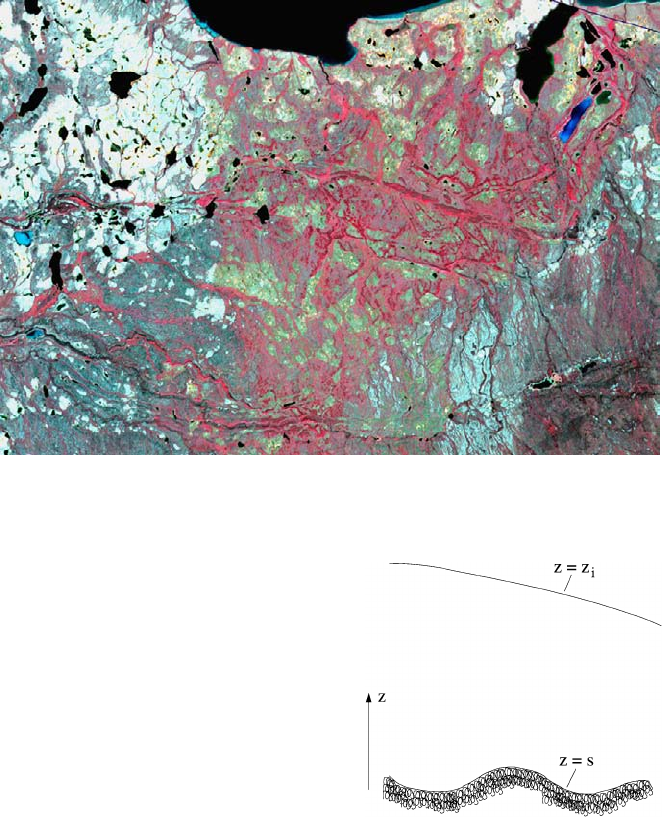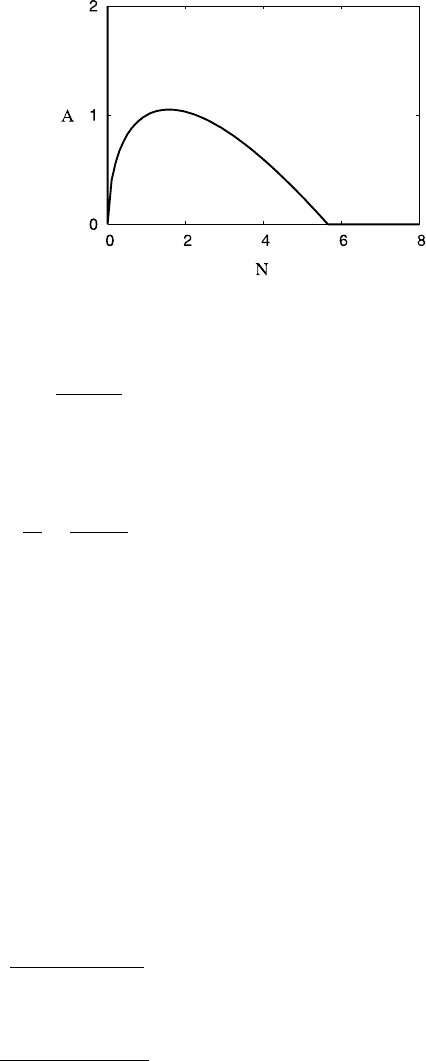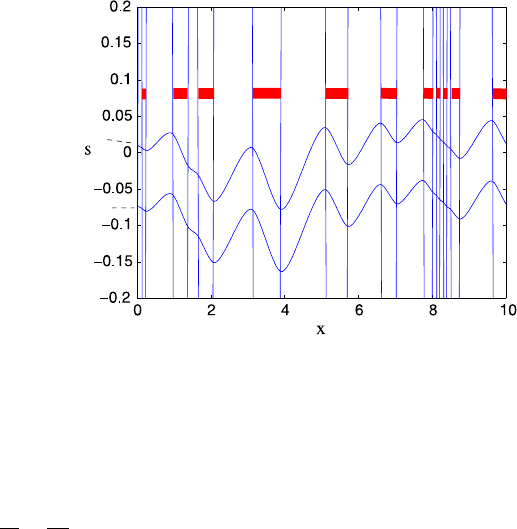Fowler A. Mathematical Geoscience
Подождите немного. Документ загружается.


690 10 Glaciers and Ice Sheets
Fig. 10.18 A system of eskers in Northern Canada. This false colour satellite image shows the
eskers as the criss-crossed red linear features
Fig. 10.19 System geometry
where q is the basal sediment flux. Ideally, q would be determined in the field or lab-
oratory, but this is not very practicable. Alternatively, we might propose a sediment
transport law based on a presumed rheology of the till. This also is problematic,
since the determination of the rheology of granular materials is difficult and con-
troversial. For the present purpose, we can largely avoid the issue, recognising only
that there is sediment transport (q =0), and that it is likely to depend on both the
basal shear stress τ and the basal effective pressure N, thus
q =q(τ,N). (10.348)

10.5 Drumlins and Eskers 691
Ice Flow
For simplicity we suppose the flow of ice is Newtonian, with a constant viscosity η.
In two dimensions, the equations for the velocity (u, w) can be written in the form
u
x
+w
z
=0,
0 =−Π
x
−ρ
i
gz
i
+η∇
2
u, (10.349)
0 =−Π
z
+η∇
2
w,
where Π is the reduced pressure defined earlier, and z
i
=
∂z
i
∂x
.
Surface Boundary Conditions
The conditions which we apply at the surface are those of stress continuity and a
kinematic condition, which take the form
Π −τ
nn
=0,τ
nt
=0,w=
∂z
i
∂t
+u
∂z
i
∂x
−a at z =z
i
, (10.350)
where τ
nt
is the shear stress, a is the accumulation rate. We can anticipate that the
horizontal length scale of interest will be that of drumlins, thus in the range 100–
1000 m, and much less than the horizontal length scale appropriate to ice sheets.
Therefore it seems reasonable to suppose that z
i
will be almost constant, and the
boundary conditions (10.350) can be approximately applied at a flat interface. Al-
though the regional slope of the ice surface is negligible geometrically, it is neces-
sary to retain it in the force balance equation (10.349).
24
There is an alternative possibility for the upper boundary condition, which arises
in the case that the parameter
σ =
l
d
i
(10.351)
is small, where l is the horizontal drumlin length scale and d
i
is the ice depth scale.
In this case, the flow near the base is akin to a boundary layer flow, and the appro-
priate condition is a matching condition to the outer ice sheet flow, which sees the
base as essentially flat with small scale wrinkles. Assuming this outer ice sheet flow
is a shear flow which varies on a horizontal length scale d
i
, appropriate matching
conditions are
Π →0,ηu
z
→τ
b
,w→0asz →∞. (10.352)
The quantity τ
b
is the basal shear stress determined by the outer flow, and is given
by
τ
b
=−ρ
i
gz
i
z
i
. (10.353)
24
This is analogous to the Boussinesq approximation in convection: the surface slope is important
in determining the driving stress, but negligible otherwise.

692 10 Glaciers and Ice Sheets
It is not clear which of the limits for σ is the more appropriate. Four hundred
metre drumlins under eight hundred metres of ice suggest σ = O(1), but two hun-
dred metre drumlins under two thousand metres of ice suggest σ 1. Nor is it clear
whether there might be any essential difference in the resulting stability analysis.
Since the limit σ 1 is the simpler, we focus henceforth on that case.
Basal Boundary Conditions
To write the basal boundary conditions, we need to construct the normal and shear
stress, and the tangential velocity, using the unit normal and tangent vectors. (In
three dimensions, there are two tangent vectors to be used, see Question 10.16.)
In two dimensions, the normal and shear deviatoric stresses are
−τ
nn
=
2η
1 +s
2
x
1 −s
2
x
u
x
+s
x
(u
z
+w
x
)
,
τ =
η
1 +s
2
x
1 −s
2
x
(u
z
+w
x
) −4s
x
u
x
.
(10.354)
We suppose that there is a sliding velocity, which we denote by U, and as for
sediment transport, we suppose that this depends on the interfacial shear stress
25
τ
and interfacial effective pressure N. Accounting for the tangential velocity at the
bed, the sliding law then takes the form
u +ws
x
(1 +s
2
x
)
1/2
=U(τ,N). (10.355)
As for the sediment transport, we avoid specification of how sliding is achieved; it
might be by deformation of the underlying till, or by slip at the ice-till interface. In
either case we expect dependence of U on τ and N.
The final condition at the bed is the kinematic condition,
w =s
t
+us
x
; (10.356)
we ignore interfacial melting, usually of the order of millimetres per year, and neg-
ligible in this context.
Between them, Eqs. (10.345), (10.348), (10.354), (10.355) and (10.356) need to
provide a total of two interfacial boundary conditions for the ice flow; the Exner
equation (10.347) provides the evolution equation for s. We can take the two in-
terfacial conditions to be the velocity conditions (10.355) and (10.356), which are
given in terms of τ , N and s. Then (10.345) and (10.354)
1
determine N,(10.347)
and (10.348) determine s, and (10.354)
2
determines τ . The model is therefore com-
plete.
25
Some confusion is liable to occur between the values of shear stress and other quantities at the
ice-till interface, and the values of these quantities far from the interface, because it is normal to
refer to the far field values as ‘basal’, since on the ice sheet scale, they are at the base of the large
scale ice flow. We will endeavour to avoid this confusion by referring to ‘far field’ and ‘interfacial’
values (despite having defined the basal shear stress in (10.353)!).

10.5 Drumlins and Eskers 693
A Reduced Model
We begin by non-dimensionalising the model. There are a number of length scales
present in the equations. We define the quantities
z
i
∼d
i
,d
D
=
N
c
ρ
iw
g
,d
T
=
N
c
ρ
sw
g(1 −φ)
. (10.357)
These length scales are the ice depth scale d
I
, the drumlin depth scale d
D
, and the till
deformation depth scale d
T
. To explain the significance of these scales, we resume
our earlier discussion of till deformation.
Subglacial till is a granular material, consisting of rough angular fragments in a
matrix of finer-grained material, the whole being water saturated when it is being
deformed. In common with all granular materials, we expect that when subjected
to a shear stress, it will not deform until the shear stress exceeds a critical value,
called the yield stress. The reason for this is simple, insofar as we expect two solid
surfaces not to permit sliding until the static coefficient of friction is exceeded. More
specifically, if the normal stress between two clasts is p
e
, and the shear stress is τ ,
then slip will occur if
τ>μp
e
, (10.358)
where μ is the coefficient of friction. More generally, the Mohr–Coulomb yield
stress τ
c
in a granular material is
τ
c
=c +μp
e
, (10.359)
where c is the cohesion, often ignored as being small for subglacial till. The coeffi-
cient μ is of O(1), and is related to the angle of friction φ
f
by μ =tan φ
f
.
If we now consult (10.339) and (10.345), two observations can be made. Till
deformation will cease at effective pressures larger than τ/μ. Typical basal shear
stresses are likely to be in the range 0.1–1 bar, so that till will only deform at all if
p
e
is of this order. In particular, till deformation can only occur at values of N
c
1
bar. Such low values of the effective stress have been measured under the Ross ice
streams, and may be associated with a distributed, canal type of drainage. Assuming,
then, that τ ∼N
c
, we see from (10.339) that till deformation is only viable to a depth
of order d
T
, as defined in (10.357). Below this depth, the effective pressure is too
large to promote till deformation. This observation allows us to suggest a typical
value of till transport.
The second observation is drawn from (10.345). If we anticipate that drumlins
grow as a consequence of instability of a flat bed, then the effective pressure in-
creases with drumlin elevation. When the drumlins attain an elevation of order d
D
given by (10.357), the summit effective pressure will be large enough to slow down
the till and thus also deformation, which presumably stunts further growth. This
depth scale thus provides an estimate for the eventual height of drumlins. Choosing
N
c
= 0.4 bars gives a depth scale of 50 m, although numerical solutions generally
give smaller values.

694 10 Glaciers and Ice Sheets
We use these ideas in choosing scales for the variables. It is first convenient to
define a stream function for the flow via
ψ
z
=u, −ψ
x
=w. (10.360)
We take the basic shear flow without bed perturbations to be
ψ =u
0
z +
τ
b
2η
z
2
, (10.361)
and a dimensionless mean velocity ¯u(t) is introduced as the developing bedforms
alter the average sliding velocity. Specifically, we scale the model by choosing
z
i
=d
i
h, x, z ∼l, p
e
,N,Π,τ
nn
,τ ∼N
c
,s∼d
D
,
ψ =u
0
¯uz +
τ
b
2η
z
2
+u
0
d
D
Ψ, U ∼u
0
,q∼u
0
d
T
,t∼
d
D
l
d
T
u
0
,
(10.362)
and we scale the depth of the till by writing
s −z =d
T
ζ. (10.363)
Thus the dimensionless effective pressure in the till is
p
e
=N +ζ, (10.364)
and the yield criterion (10.358) becomes
ζ<
τ
μ
−N. (10.365)
The value of u
0
is determined by the magnitude of the sliding velocity, and the
horizontal length scale is defined by balancing the stress and strain rates, thus
l =
ηu
0
d
D
N
c
1/2
=
ηu
0
ρ
iw
g
1/2
. (10.366)
If we choose u
0
= 100 m y
−1
and η = 6 bar year (≈2 × 10
13
Pa s), then l =
271 m. Other typical values, with ρ
s
= 2.5 ×10
3
kg m
−3
and n = 0.4, are d
T
=
4.6 m, and the time scale is 29 y.
26
With this choice of scaling, the dimensionless model for the ice flow is
0 =−Π
x
+∇
2
Ψ
z
+σθ,
0 =−Π
z
−∇
2
Ψ
x
,
(10.367)
with far field boundary conditions (appropriate for small σ )
Π →0,Ψ→0asz →∞. (10.368)
26
This time scale is rather long, given recent observations of bedforms growing in a matter of years.
As we shall see below, the instability does in fact occur on a much shorter time scale (and also on
a shorter length scale).

10.5 Drumlins and Eskers 695
The basal conditions take the form
−τ
nn
=
2[(1 −ν
2
s
2
x
)Ψ
zx
+νs
x
(θ +Ψ
zz
−Ψ
xx
)]
1 +ν
2
s
2
x
,
τ =
(1 −ν
2
s
2
x
)(θ +Ψ
zz
−Ψ
xx
) −4νs
x
Ψ
zx
1 +ν
2
s
2
x
,
¯u +νθz +νΨ
z
−ν
2
Ψ
x
s
x
(1 +ν
2
s
2
x
)
1/2
=U(τ,N),
−Ψ
x
=αs
t
+[¯u +νθz +νΨ
z
]s
x
,
N =1 +s +Π −τ
nn
,
s
t
+q
x
=0,
(10.369)
and these are all applied at z =νs.
The dimensionless parameters σ , θ , ν and α are defined by
σ =
l
d
i
,θ=
τ
b
N
c
,ν=
d
D
l
,α=
d
T
d
D
. (10.370)
Supposing l =300 m, d
i
=1500 m, thus τ
b
=0.15 bar with an assumed ice surface
slope of 10
−3
, d
D
=50 m, N
c
=0.4 bar, d
T
=5 m, typical values are
σ ∼0.2,θ∼0.38,ν∼0.16,α∼0.1. (10.371)
We now simplify the model by considering the aspect ratio ν 1. Putting ν =0
(and putting σ =0 in the momentum equations), the reduced model is then
0 =−Π
x
+∇
2
Ψ
z
,
0 =−Π
z
−∇
2
Ψ
x
,
(10.372)
with matching condition (10.368), and interfacial conditions applied at z =0:
−τ
nn
=2Ψ
zx
,
τ =θ +Ψ
zz
−Ψ
xx
,
¯u =U(τ,N),
−Ψ
x
=αs
t
+¯us
x
,
N =1 +s +Π −τ
nn
,
s
t
+q
x
=0.
(10.373)
The stability of the uniform solution of this reduced model is studied in the follow-
ing subsection.
It is straightforward to carry through this procedure in three dimensions (see also
Question 10.16), and here we simply state the result. The position coordinates are
now (x,y,z), with y being the transverse horizontal coordinate, and the correspond-
ing velocity vector is (u,v,w)=u. The reduced dimensionless model is
∇Π =∇
2
u,
∇.u =0,
(10.374)
subject to
Π →0,u
z
→θ, v, w →0asz →∞, (10.375)

696 10 Glaciers and Ice Sheets
and
τ
nn
=2w
z
,
τ
1
=θ +u
z
+w
x
,
τ
2
=v
z
+w
y
,
τ =
τ
2
1
+τ
2
2
1/2
,
¯u =
U(τ,N)τ
1
τ
, (10.376)
0 =
U(τ,N)τ
2
τ
,
w =αs
t
+¯us
x
,
N =1 +s +Π −τ
nn
,
s
t
+∇.q =0,
all applied at z =0. One might suppose that, since also α is quite small, it too could
be neglected. As our linear stability analysis will show, this is not possible, since it
provides a stabilising term at high wave number.
Ice Flow Solution
Reverting to the two-dimensional problem, the ice flow problem is linear, and can
be solved conveniently using the Fourier transform
ˆ
f(k)=
∞
−∞
f(x)e
ikx
dx; (10.377)
omitting details, we then find that
N =1 +s −2H{αs
xt
+¯us
xx
}, (10.378)
where the Hilbert transform is
H(g) =
1
π
−
∞
−∞
g(t)dt
t −x
. (10.379)
The interfacial shear stress τ ≈τ
1
can be inverted to the form
τ =f(¯u, N ), (10.380)
while a horizontal average of this yields the condition
θ =
f(¯u, N), (10.381)
which serves to specify the average dimensionless sliding velocity ¯u.
The sediment flux q was taken to depend on τ and N. It is the product of a dimen-
sionless deformable till thickness A and a mean velocity V , which we suppose is

10.5 Drumlins and Eskers 697
Fig. 10.20 The function
A(N) givenby(10.382),
where f(¯u, N) =θ ¯u
a
N
b
.
The parameters used are
b =0.6, μ =0.4, θ =0.8,
¯u =1
constrained by the ice velocity ¯u. The deformable depth is constrained by (10.365),
which suggests that we choose
A =A(N) =
f(¯u, N)
μ
−N
+
(10.382)
([x]
+
=max(x, 0)). Since we suppose V ∼¯u, which itself depends on N ,wemay
as well take V =1 and thus q =A. Our model for bed elevation is thus completed
by solving the Exner equation
∂s
∂t
+
∂A(N)
∂x
=0, (10.383)
together with the normal stress condition (10.378). Note that this is a nonlinear
model for the bed elevation. A typical form of the sediment flux function q =A is
shown in Fig. 10.20.
Linear Stability
We now consider the linear stability of the reduced, two-dimensional model
(10.378) and (10.383). The basic uniform state is (assuming the sliding law τ =
θ ¯u
a
N
b
)
N =1,s=0. (10.384)
For simplicity we suppose ¯u ≡1, which is in any case valid in the linearised theory.
We linearise about this basic state by putting N = 1 + P , and linearising for
small s and P . Denoting the transforms with an overhat, and using the facts that
f
x
=−ik
ˆ
f and
H(g
x
) =−|k|ˆg, we find that ˆs ∝e
σt
, with
σ =
ikA
(1 −2ik|k|)
1 −2ik|k|αA
, (10.385)
where A
=A
(1). With σ =r +ikc, this implies that the growth rate is
r =
2k
2
|k|A
(1 −αA
)
1 +4α
2
A
2
k
4
, (10.386)

698 10 Glaciers and Ice Sheets
and the wave speed is
c =
A
(1 +4αA
k
4
)
1 +4α
2
A
2
k
4
. (10.387)
Bearinginmindthatα is relatively small, we see from (10.386) that the flat bed
is unstable if A
> 0, or equivalently if q
> 0. Since q =q(τ,N) and τ =f(u,N),
we can interpret this instability criterion as follows. If we draw the two families of
curves τ =f(u,N)with constant u, and q =q(τ,N) with constant q in the (N, τ )
plane, then the criterion q
> 0 is equivalent (assuming q
τ
> 0) to
dτ
dN
u
>
dτ
dN
q
. (10.388)
This criterion is easily satisfied for reasonable choices of sediment flux and sliding
law. If we use the sliding law τ =θu
a
N
b
, then the instability criterion is
θ>
μ
b
. (10.389)
Providing the base of the ice is at the melting point, (10.389) shows that drumlins
will form for large enough basal shear stress, or for low enough channel effective
pressure. If we suppose that b is close to one, corresponding to a ‘plastic’ till, then
the instability criterion is that τ
b
μN
c
, which is simply the criterion that the till
should deform. Roughly speaking, we can expect drumlinisation wherever till de-
forms.
The wave speed c is positive, and the growth rate has a maximum at a wave
number
k =k
max
=
3
1/4
(2αA
)
1/2
. (10.390)
If we take α = 0.1 and A
=
1
3
, then
2π
k
max
≈ 1.23, corresponding to a dimensional
wavelength of 334 m. The corresponding growth time scale is
t
max
=
1
r
≈
1 +4α
2
A
2
k
2
max
2k
3
max
A
≈0.038, (10.391)
corresponding to a dimensional growth time of thirteen months. It is a hallmark of
the instability that it is rapid.
Nonlinear Results
The main difficulty in computing finite amplitude solutions of the model (10.378)
with (10.383) is that as the instability develops, N decreases until it inevitably
reaches zero; physically, cavities form in the lee of obstacles. If s continues to de-
note the base of the ice flow, then while (10.378) still applies, the Exner equation
(10.383) must be replaced by the cavitation condition
N =0. (10.392)

10.5 Drumlins and Eskers 699
Fig. 10.21 Finite amplitude
till surface obtained from
solving (10.393) with a
suitable approximation for
A(N) resembling Fig. 10.20.
The two surfaces are the ice
base and the base of the
deformable till layer (which
is actually s −αA). The thick
horizontal bands indicate the
cavities, where N = 0
This makes the model difficult to solve numerically. One way round this is to con-
tinue to solve (10.383), but to extend the definition of A so that it is any positive
value when N = 0. As in fact indicated in Fig. 10.20, this makes A a piecewise
smooth graph. The combined model is thus
N =1 +s −2H{αs
xt
+¯us
xx
},
∂s
∂t
+
∂a
∂x
=0,
(10.393)
with
a =A(N), N > 0,
a>0,N=0.
(10.394)
In practice, we approximate the graph of A by a smooth non-monotonic function.
Despite this, the model is difficult to solve numerically. This is because as the os-
cillations grow, a transition takes place when the maximum of A is reached. When
this happens, there is a rapid transition to a state in which N is piecewise constant,
being positive on the upstream face of the bedforms, and (approximately) zero on
the downstream cavities. At this transition, a spectral method (used because of the
nice properties of the Hilbert transform in Hilbert space) generates transient high
frequency components which can cause numerical breakdown. Figure 10.21 shows
the result of one such calculation, in which the positions of the cavities are indi-
cated by the horizontal bands. In this model, the drumlins reach a stationary state.
In more detailed models, they form finite amplitude travelling waves, as discussed
in the notes.
10.5.2 Eskers
Eskers are long, sinuous ridges of sand and gravel which, like drumlins, are asso-
ciated with the existence of former ice sheets. They are thought to form through
